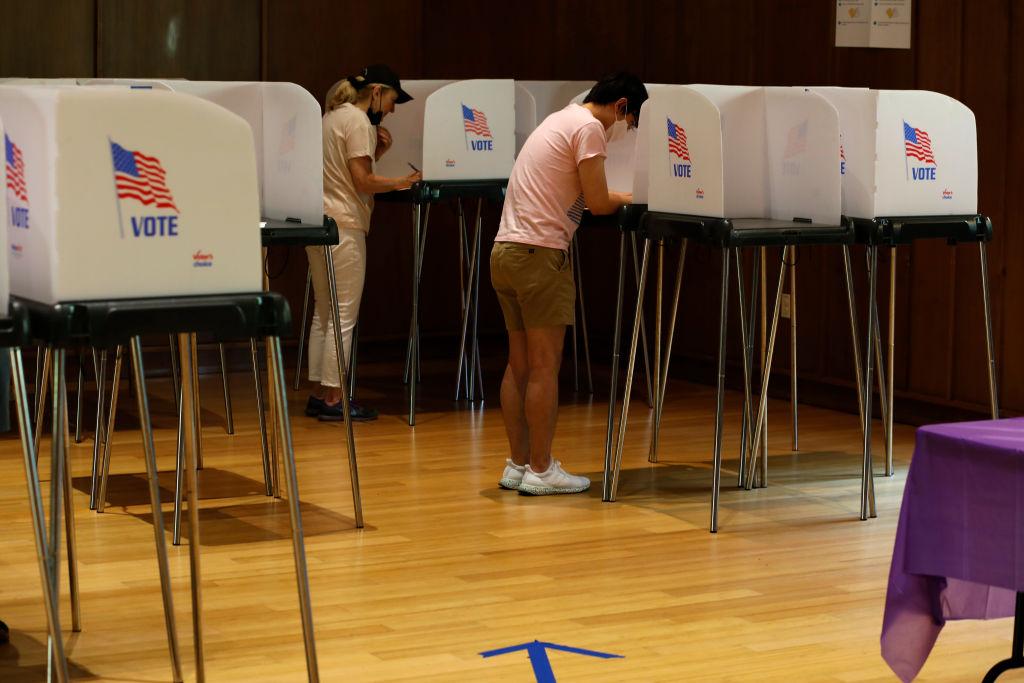
SILVER SPRING, MD – JULY 19: People vote at the Silver Spring Civic Center on July 19, 2022. Today is the primary election in Maryland. (Photo by Robb Hill for The Washington Post via Getty Images)
The results of the Maryland primary races are coming in fast and furious. The picture so far shows a solid night for Trumpian candidates and a business-as-usual scorecard for hopeful Democrats. But why is the left celebrating an apparent win from a GOP candidate it labeled “far right”? And has President Biden’s party locked itself into a high-risk electoral strategy?
Although the final tally will not be announced for several days owing to mail-in ballots not due to be counted until 10 a.m. on Thursday morning, many of the races have a clear outcome.
Shenanigans Afoot in Maryland Primary Races
In the last 20 years, despite being a Democrat stronghold, the left has lost more gubernatorial races than it has won in Maryland, returning a GOP candidate in three of the last five contests. The Old Line State is a prize that has proven elusive, but this season, Dems have a plan.
Governor Larry Hogan (R) – who will be stepping down due to term limits – endorsed former state lawmaker and secretary of commerce, Kelly Schulz, for the primary. Her main challenger, state Delegate Dan Cox, has the backing of former President Donald Trump. With roughly 80% of the vote counted, Cox is a clear 16 points ahead of Schultz and certain to be the nominee.
 Cox benefited not only from Trump’s endorsement but also from funding from an unusual source. Once again, the Democratic Governors Association (DGA) opted to get involved in the GOP primary process – this time to the tune of $2 million. Across the nation, the DGA has been spending big on candidates it believes will be easier to beat come November: namely, those who are major supporters of Trump.
Cox benefited not only from Trump’s endorsement but also from funding from an unusual source. Once again, the Democratic Governors Association (DGA) opted to get involved in the GOP primary process – this time to the tune of $2 million. Across the nation, the DGA has been spending big on candidates it believes will be easier to beat come November: namely, those who are major supporters of Trump.
Cox will likely go head-to-head in the gubernatorial contest against first-time candidate Wes Moore, who, with 60% of the vote counted, has almost a ten-point lead over former DNC chair Tom Perez.
A Dangerous Strategy
But what is the logic behind backing a non-establishment, Trump-endorsed candidate? Consider that Moore, a political neophyte, appears to have secured the Democrat nomination against one of the most recognizable party insiders, Perez. This presents more than a subtle hint that Maryland primary voters may not be ready or willing to accept the next-in-line party hack.

(Photo by Robb Hill for The Washington Post via Getty Images)
The strategy of interference in Republican primaries is based on the idea that fewer funds will have to be spent to defeat a “dangerous,” “far-right” candidate, and thus, precious donation dollars can be better spent elsewhere on more competitive races. But this presupposes that voters in 2022 and beyond will vote the same way they did in 2020. And that is far from certain.
With Biden overseeing record-high gas prices, massive inflation, a border crisis of horrific magnitude, and generally being unpopular with his own base, the voters may decide that a little creative disruption is just what the doctor ordered.
Rude Awakenings?
The DGA is committed to its plan of pushing forward “deplorable” GOP candidates. Datasheets, number crunchers, and party strategists are convinced this will produce solid Democrat returns in November. And while the scheme makes a certain amount of political sense, we all know how betting against the deplorables turned out for Hillary Clinton in 2016.
Remember to check out the web’s best conservative news aggregator
Whatfinger.com — the #1 Alternative to the Drudge


